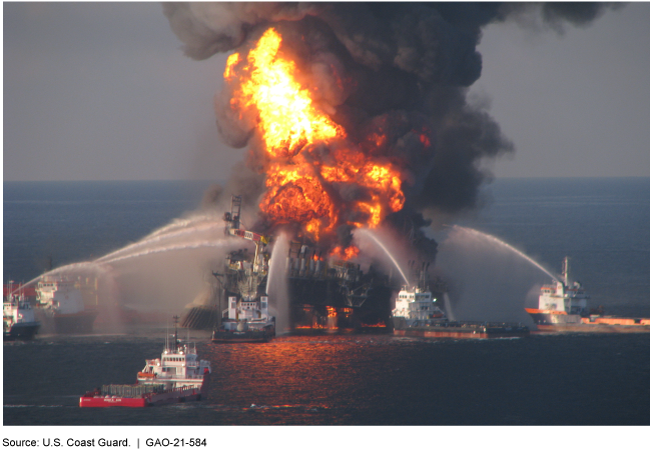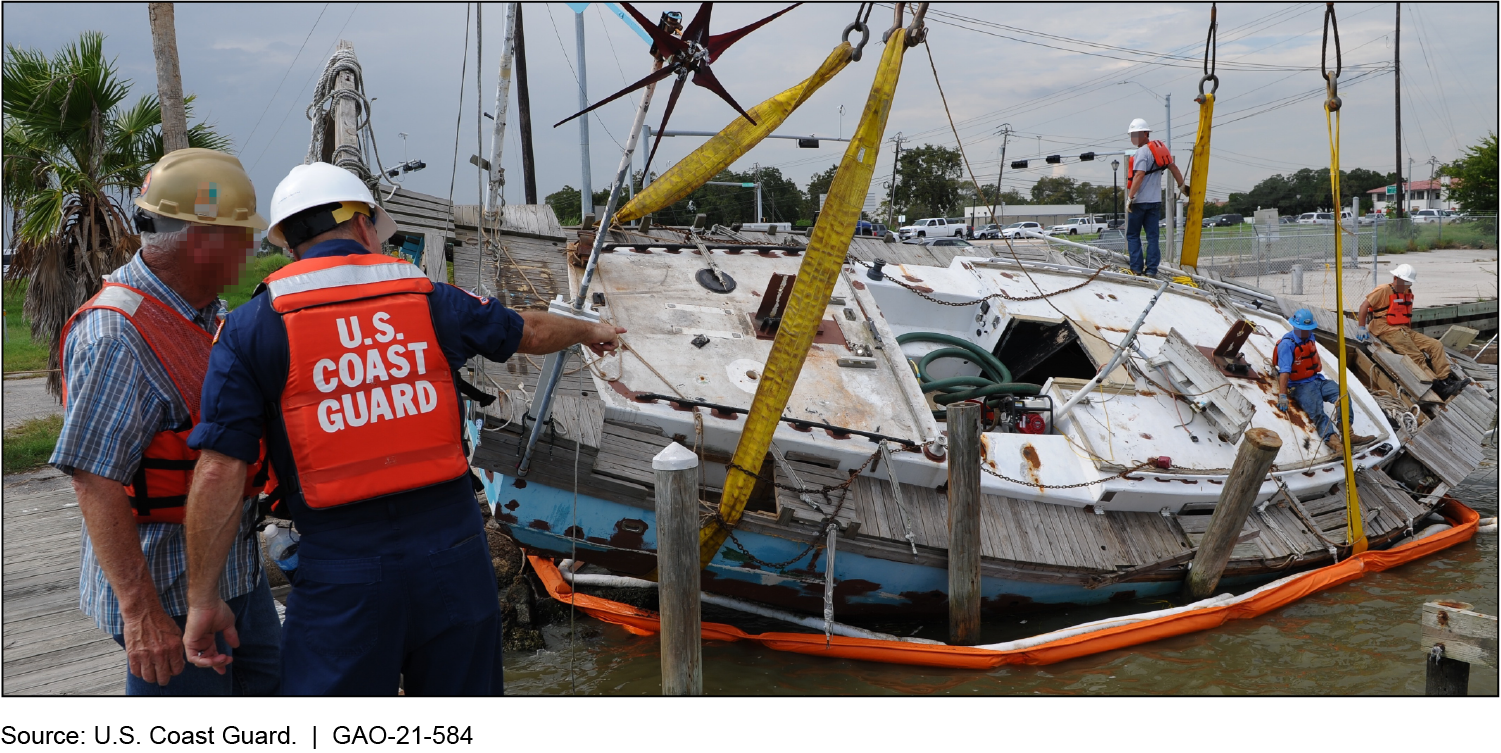Coast Guard: A More Systematic Process to Resolve Recommended Actions Could Enhance Future Surge Operations
Fast Facts
From 2007-2020, the U.S. Coast Guard conducted 23 major surge operations—high-intensity, short-notice emergency responses to catastrophic events, like hurricanes or oil spills. During these surges, the Coast Guard deployed varying numbers and types of personnel, aircraft, and vessels based on event severity and duration.
The Coast Guard documents lessons learned and best practices from surge operations—developing recommendations to improve future surges. But, the Coast Guard does not have a systematic process in place to track, update, and resolve all recommendations. We recommended that it establish such a process.
The U.S. Coast Guard conducting surge operations in response to the Deepwater Horizon Explosion and Oil Spill in 2010

Highlights
What GAO Found
From 2007 through 2020, the Coast Guard conducted 23 major surge operations—high-intensity, short-notice efforts to respond to catastrophic events or emergencies, such as hurricanes, oil spills, and humanitarian events. To support these surge operations, the Coast Guard deployed varying levels of personnel, aircraft, and vessels according to the events’ severity and duration.
Photo of Coast Guard Personnel Responding to Hurricane Harvey (2017)

The Coast Guard documents lessons learned and best practices from its major surge operations and develops recommended actions to help improve future operations. The Coast Guard also has processes for assigning recommended actions to appropriate headquarters offices and field units. However, GAO’s analysis of Coast Guard data on major surge operations shows that it has not met its goals of (1) resolving 80 percent of recommended actions or (2) resolving the actions within 18 months of being assigned. GAO analysis also found that Coast Guard headquarters offices have a higher proportion of unresolved recommended actions compared with field units. The Coast Guard Strategic Plan for 2018-2022 calls for acting on lessons learned and best practices from surge events as important factors for improving emergency management. However, the Coast Guard lacks assurance that recommended actions to address surge operation deficiencies are tracked, updated, and resolved in line with program goals. Without a more systematic process to help ensure that this occurs, the Coast Guard may not address identified issues that could affect its ability to effectively conduct future surge operations.
The Coast Guard was generally able to meet statutory mission performance targets in years that it also conducted surge operations. While Coast Guard data showed variation in mission activities in years with concurrent or back-to-back surge operations, GAO was not able to determine the effect that surge operations had on mission activities because of multiple factors beyond surge operations, such as personnel transfers, that can also affect mission activities. Additionally, Coast Guard officials did not identify any statutory or regulatory impediments to the Coast Guard’s ability to conduct surge operations.
Why GAO Did This Study
The U.S. Coast Guard has multimission responsibilities to support response efforts and help protect life, property, and the environment. The Coast Guard must often rely on surge operations to reduce the impacts of catastrophic events, such as the Deepwater Horizon oil spill in 2010 and Hurricanes Harvey, Irma, and Maria in 2017.
The William M. (Mac) Thornberry National Defense Authorization Act for Fiscal Year 2021 includes a provision for GAO to review the Coast Guard’s surge capacity to respond to catastrophic events. This report addresses (1) the number of major surge operations the Coast Guard conducted from 2007 through 2020, and what personnel and assets it used to support these operations; (2) the extent the Coast Guard documents lessons learned and best practices from its major surge operations and resolves related recommended actions; and (3) how surge operations have affected the Coast Guard's ability to conduct its statutory missions. GAO reviewed, among other things, documentation from Coast Guard surge operations from 2007 through 2020; analyzed after-action reports and performance metrics; and interviewed Coast Guard officials.
Recommendations
GAO recommends that the Coast Guard establish a more systematic process for ensuring that recommended actions are tracked, updated, and resolved in line with Coast Guard goals. The Department of Homeland Security concurred with this recommendation.
Recommendations for Executive Action
| Agency Affected Sort descending | Recommendation | Status |
|---|---|---|
| United States Coast Guard | The Commandant of the Coast Guard should establish a more systematic process for ensuring that assigned recommended actions are tracked, updated, and resolved in line with the Coast Guard's resolution rate and timeliness goals. (Recommendation 1) |
Open
DHS and the Coast Guard concurred with this recommendation and, in its official agency response letter, identified five actions that the Coast Guard would take to implement the recommendation. In February 2023, the Coast Guard informed GAO that it expects to complete three of the actions by February 28, 2023. Specifically, it plans to create and institute a metric that would require a designated action office to provide an initial comment regarding the approach to resolving the recommended action, within 30 days of being assigned the action. The Coast Guard also plans to update the Commandant Instruction 3010.19 (series), "Coast Guard After Action Program." The update is to clarify (a) the role of action offices assigned a recommended action; (b) requirements for commenting and resolution; and (c) requirements for designating an action officer for each task. The third action it plans to complete by February 28, 2023 is to review outstanding recommended actions in order to identify lead offices and action officers for each action; and to provide outreach and instruction for utilizing CPS to update progress and resolve recommended actions. In addition to these three actions, the Coast Guard plans to change the Contingency Preparedness System (CPS) to allow the identification of lead and supporting offices for recommended actions by September 30, 2023. Finally, the fifth action the Coast Guard plans to take in order to implement the recommendation is to create CPS dashboards showing progress toward resolution of outstanding recommended actions, as well as generate automatic notifications to action officers to inform them of progress toward resolution. According to the Coast Guard, it had requested funding for fiscal year 2023, and plans to complete this within two years of funding being made available. To fully address this recommendation, the Coast Guard will need to complete these five actions.
|
